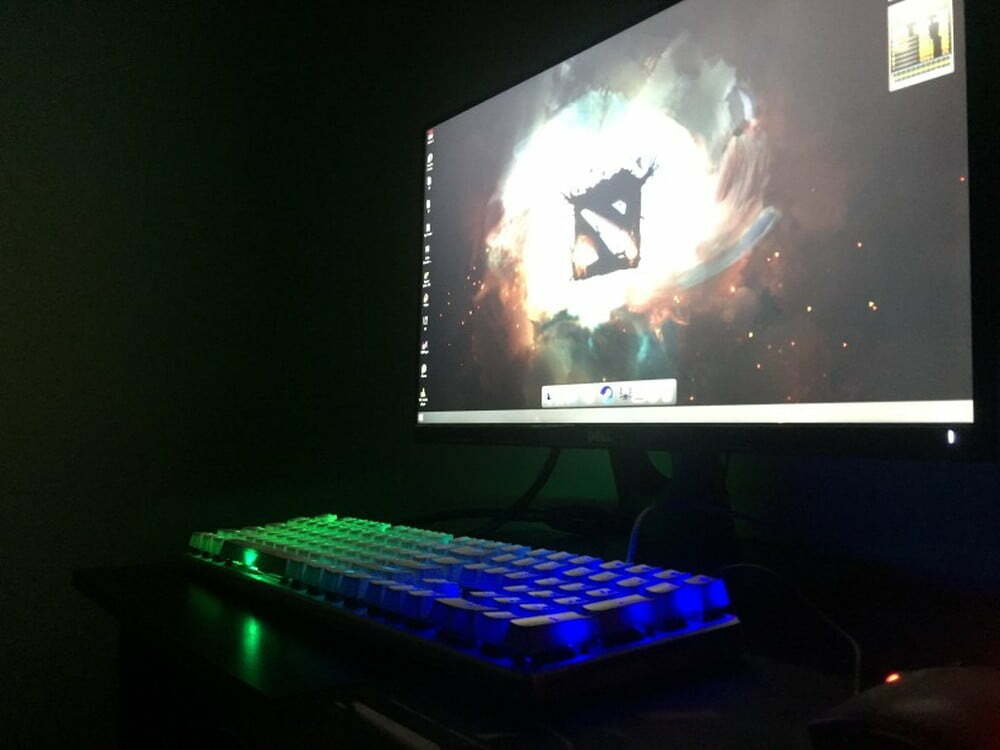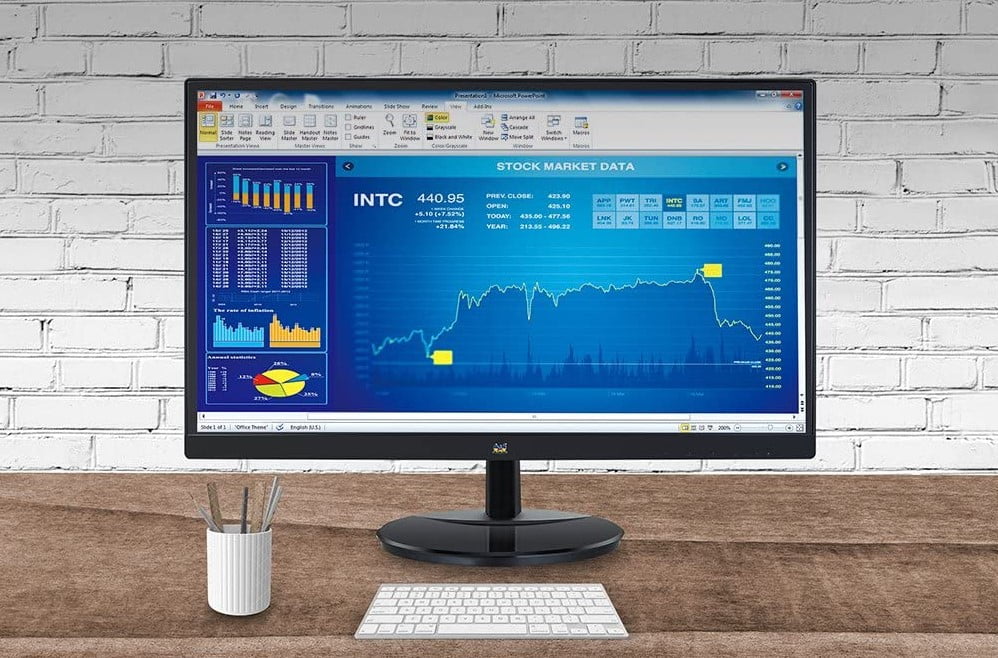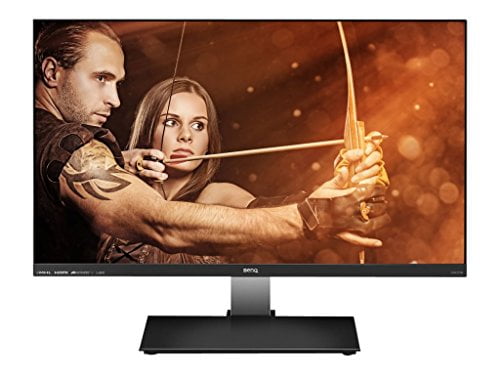If you are shopping for a new display, you may consider LCD vs LED monitors for gaming. The best gaming monitors come in both types, after all. Keep reading to find out the differences between the two and how to choose the best monitor for your gaming needs.
KEY TAKEAWAYS:
- LCD monitors tend to be cheaper and more readily available than LED displays, thanks to decades of standard-setting. Both make for a great gaming monitor.
- LED displays are newer, more expensive, and offer an improved picture quality, offering deeper blacks and improved color accuracy.
- An average LED monitor is also more energy-efficient than LCD monitors, though the difference is not large.
Differences Between LCD and LED Monitors
The primary difference between LCD and LED monitors is the method of illumination used. Liquid crystal display (LCD) monitors use a series of lamps placed at the back of the screen to light up visual images, while light-emitting diode (LED) monitors use, well, a whole lot of light-emitting diodes to illuminate the screen. Technically speaking, LED monitors are a subset of LCDs, making the differences between the two not as stark as when comparing HDMI vs DVI setups for gaming. Here are some unique contrasts between LCD and LED gaming monitors.
Image Quality
When it comes to the overall image quality, LED monitors have a slight leg up, due to the nature of their design. LED displays offer improved black levels and an improved contrast ratio over LCD monitors. The same can be said for color accuracy, which you’ll find on many of the best 24-inch gaming monitors. Additionally, some LED monitors up the game by including full-array back-lit displays with local dimming, for even more improved picture quality. The differences between the two, especially concerning color accuracy, are like comparing limited RGB to full RGB displays.
Size and Energy Usage
When it comes to the overall size (including 24-inch vs 27-inch gaming monitors), weight, and energy consumption, LED monitors come out on top. LCDs are not extremely heavy, and are on the thinner side, but LED screens tend to be the best monitors for productivity and gaming. This is because light-emitting diodes are lighter and smaller than the fluorescent lamps found in LCD monitors. As for energy consumption, LED monitors are extremely efficient, saving energy over time.
Monitor Cost
LED monitors tend to be more expensive than LCD screens, thanks to LED technology being newer and featuring pricier components. Additionally, there is a newer form of LED called the OLED, which stands for Organic Light-Emitting Diode. These OLED displays are extremely expensive, especially at high resolutions. LED technology, on the other hand, is extremely cheap and readily available.
Insider Tip
Both types of monitors will be a great choice for most modern games, though read the recommended specs before purchasing any game.
F.A.Q.
Are LCD monitors different?
LCD monitors are essentially the modern standard, though LED displays are catching up. Both allow for stellar refresh rates, quick response times, decent brightness levels, and more.
How to control your spending on video games?
You may want to choose an LCD over an LED monitor, as it will be cheaper. LCD technology is cheaper than LED lights.
Does color accuracy matter?
Ballpark color accuracy certainly matters, but perfection is not needed unless you are a video editor or a photo editor. Other specs, such as refresh rates, response times, and dimming capabilities are more important.
STAT: In 2020, gaming monitor shipments worldwide reached 18.4 million units, with forecasts for 2021 suggesting that this is likely to rise to 25.9 million units. (source)
REFERENCES:
- https://www.statista.com/statistics/818450/gaming-monitor-unit-shipments-worldwide/
- https://en.wikipedia.org/wiki/LED_display
- https://en.wikipedia.org/wiki/Liquid-crystal_displayr
- http://hs.windows.microsoft.com/hhweb/content/m-en-us/p-6.2/id-617624ee-08f3-4aff-9713-5e84a9674a26/
- https://www.wikihow.com/Choose-a-Computer-Monitor



































![Best 27 Inch Computer Monitor in [year] 27 Best 27 Inch Computer Monitor in 2026](https://www.gadgetreview.dev/wp-content/uploads/how-to-buy-the-best-computer-monitor.jpg)
![Best BenQ Monitors in [year] 28 Best BenQ Monitors in 2026](https://www.gadgetreview.dev/wp-content/uploads/best-benq-monitor-image.jpg)
![Best ASUS Monitors in [year] 29 Best ASUS Monitors in 2026](https://www.gadgetreview.dev/wp-content/uploads/best-asus-monitor-image.jpg)
![Best Dell Monitors in [year] 30 Best Dell Monitors in 2026](https://www.gadgetreview.dev/wp-content/uploads/best-dell-monitor-image.jpg)
![Best HP Monitors in [year] 31 Best HP Monitors in 2026](https://www.gadgetreview.dev/wp-content/uploads/best-hp-monitor-image.jpg)
![Best Lenovo Monitors in [year] 32 Best Lenovo Monitors in 2026](https://www.gadgetreview.dev/wp-content/uploads/best-lenovo-monitor-image.jpg)
![Best ViewSonic Monitors in [year] 33 Best ViewSonic Monitors in 2026](https://www.gadgetreview.dev/wp-content/uploads/best-viewsonic-monitor-image.jpg)
![Best Gigabyte Monitors in [year] 34 Best Gigabyte Monitors in 2026](https://www.gadgetreview.dev/wp-content/uploads/best-gigabyte-monitor-image.jpg)
![Best Monitors for PS4 Pro Gaming in [year] 35 Best Monitors for PS4 Pro Gaming in 2026](https://www.gadgetreview.dev/wp-content/uploads/best-monitors-for-ps4-pro-image.jpg)
![Best Monitor for Xbox Series X in [year] 36 Best Monitor for Xbox Series X in 2026](https://www.gadgetreview.dev/wp-content/uploads/best-monitor-for-xbox-series-x-image.jpg)
![Best Acer Monitors in [year] 37 Best Acer Monitors in 2026](https://www.gadgetreview.dev/wp-content/uploads/best-acer-monitor-image.jpg)
![Best MSI Monitors in [year] 38 Best MSI Monitors in 2026](https://www.gadgetreview.dev/wp-content/uploads/best-msi-monitor-image.jpg)
![Best SAMSUNG Monitors in [year] 39 Best SAMSUNG Monitors in 2026](https://www.gadgetreview.dev/wp-content/uploads/best-samsung-monitor-image.jpg)
![Best LG Monitors in [year] 40 Best LG Monitors in 2026](https://www.gadgetreview.dev/wp-content/uploads/best-lg-monitor-image.jpg)
![Best AOC Monitors in [year] 41 Best AOC Monitors in 2026](https://www.gadgetreview.dev/wp-content/uploads/best-aoc-monitor-image.jpg)
![Best Philips Monitors in [year] 42 Best Philips Monitors in 2026](https://www.gadgetreview.dev/wp-content/uploads/best-philips-monitors-image.jpg)
![Best Monitors For PUBG in [year] 43 Best Monitors For PUBG in 2026](https://www.gadgetreview.dev/wp-content/uploads/best-monitor-for-pubg-image.jpg)
![Best Stream Decks in [year] 44 Best Stream Decks in 2026](https://www.gadgetreview.dev/wp-content/uploads/best-stream-deck-image.jpg)
![Best Monitors for Streaming in [year] 45 Best Monitors for Streaming in 2026](https://www.gadgetreview.dev/wp-content/uploads/best-monitor-for-streaming-image.jpg)
![Best Monitors For Flight Simulator in [year] 46 Best Monitors For Flight Simulator in 2026](https://www.gadgetreview.dev/wp-content/uploads/best-monitor-for-flight-simulator-image.jpg)

















